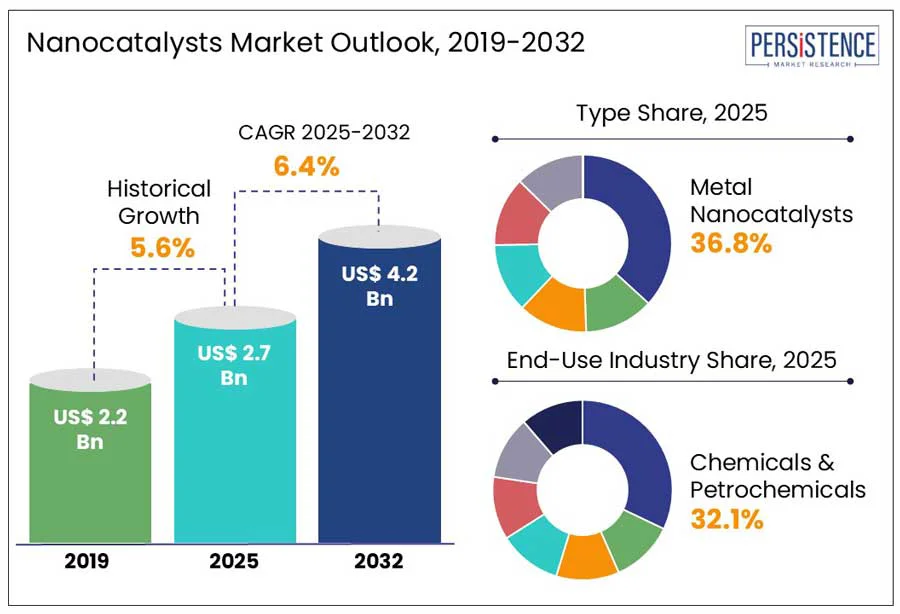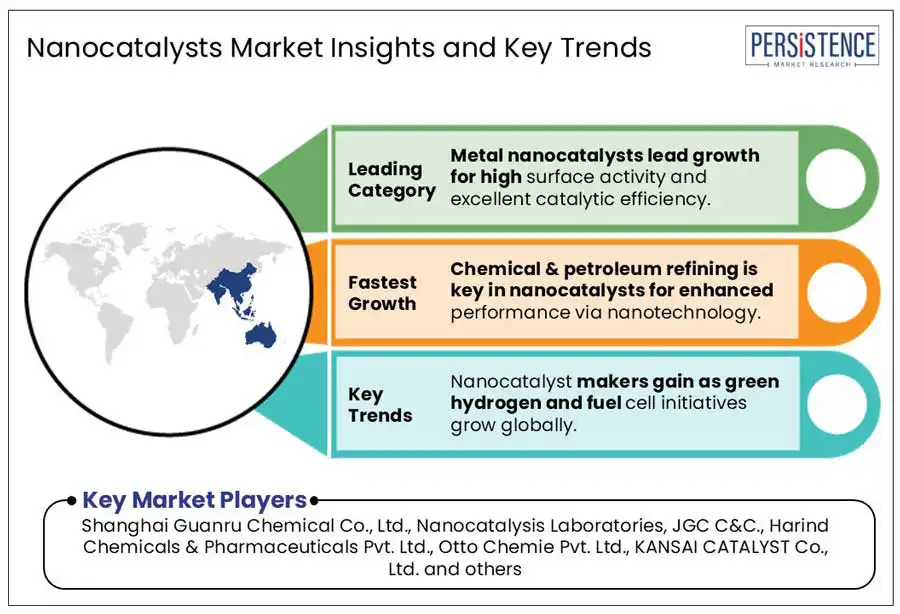ID: PMRREP3629| 198 Pages | 5 Jun 2025 | Format: PDF, Excel, PPT* | Chemicals and Materials

The global nanocatalysts market size is expected to increase from US$ 2.7 billion in 2025 to US$ 4.2 billion, reflecting a CAGR of 6.4% by 2032. According to the Persistence Market Research report, the nanocatalysts industry is emerging as a vital segment within the broader catalyst industry, driven by the unique properties of nanomaterials that enhance catalytic efficiency, selectivity, and durability. Nanocatalysts, typically made up of metal or metal oxide nanoparticles, are widely used in various industries, including energy, chemical manufacturing, environmental protection, and pharmaceuticals. Their nanoscale size significantly increases their surface area, which allows more effective catalytic reactions compared to traditional catalysts.
The growing emphasis on sustainable processes and cleaner energy solutions is driving the demand for nanocatalysts in applications such as green hydrogen production, emission control, and petroleum refining. Advances in nanotechnology and increasing industrial adoption are accelerating market growth globally. However, challenges related to regulatory approvals and large-scale commercialization remain. Despite these obstacles, the market presents promising opportunities, fueled by expanding research initiatives, government support, and the development of innovative nanocatalyst materials tailored to specific industrial needs.

Key Industry Highlights
|
Global Market Attribute |
Details |
|
Nanocatalysts Market Size (2025E) |
US$ 2.7 Bn |
|
Market Value Forecast (2032F) |
US$ 4.2 Bn |
|
Projected Growth (CAGR 2025 to 2032) |
6.4% |
|
Historical Market Growth (CAGR 2019 to 2024) |
5.6% |
The adoption of nanocatalysts has been significantly driven by the escalating need for cleaner fuel processing and increasingly stringent global emission control regulations. Advanced nanocatalytic materials are being employed to enhance refining efficiency while reducing harmful pollutant emissions. With growing scrutiny on emissions from industrial processes and vehicles, nanocatalyst-based solutions are being adopted to meet compliance and sustainability goals. Cleaner combustion and improved energy efficiency are being prioritized, as nanocatalysts-recognized for their high surface area and reactivity-are integrated into fuel processing and environmental systems.
In response to this demand, high-purity copper oxide nanoparticles (CuO) with 99.9% purity were introduced in 2024 by Anhui Fitech Materials Co., Ltd. These nanoparticles are being utilized in various catalytic applications, particularly in emission control technologies, due to their superior activity and selectivity compared to conventional powders. This development underscores the industry's commitment to environmental responsibility and reflects a broader trend toward the widespread integration of advanced nanocatalysts.
The large-scale commercialization of nanocatalysts is being restricted by stringent regulatory approvals related to environmental and safety concerns. Thorough assessments of the potential ecological impact and human health risks posed by nanomaterials are required before market introduction. Regulatory bodies are imposing rigorous testing protocols to ensure that nanocatalysts do not cause unintended toxicity or environmental damage during their lifecycle.
Due to the novelty and complexity of nanocatalysts, longer evaluation periods and uncertainty in regulatory frameworks are experienced by manufacturers. Additionally, challenges in standardizing safety guidelines and establishing comprehensive risk assessment models are encountered. Consequently, the adoption of nanocatalysts on an industrial scale is being slowed, impacting the pace at which innovative nanocatalytic technologies are brought to commercial markets.
Nanocatalyst manufacturers are experiencing significant opportunities due to the global growth of green hydrogen and fuel cell initiatives. Advanced nanocatalysts are being increasingly utilized to enhance the efficiency and durability of fuel cells and electrolyzers essential for green hydrogen production. R&D efforts are being directed toward optimizing catalyst performance while minimizing the reliance on precious metals. As governments and industries accelerate investments in hydrogen infrastructure and fuel cell technologies to support clean energy transitions, the demand for high-performance nanocatalysts is rising.
In 2024, JGC Holdings Corporation was awarded the Front End Engineering Design (FEED) contract for a green hydrogen and methylcyclohexane (MCH) production facility in Malaysia by ENEOS Corporation and Sumitomo Corporation. The project aims to generate approximately 90,000 tons of CO?-free hydrogen annually using renewable energy, later be converted into MCH for marine transport. Such initiatives underscore the crucial role of nanocatalysts in advancing scalable, sustainable hydrogen production solutions.
Metal nanocatalysts are recognized as the fastest growing segment in the nanocatalysts market due to their superior surface activity and exceptional catalytic efficiency. Their high surface-to-volume ratio provides an abundance of active sites, significantly accelerating reaction rates. Various metals such as platinum, palladium, and gold are employed for their excellent capability to drive chemical transformations. These nanocatalysts are extensively applied in fuel cells, environmental remediation, and chemical synthesis, where enhanced performance is leveraged to improve process efficiency, lower energy consumption, and support sustainable industrial practices.
In 2023, the prominence of metal nanocatalysts was underscored by Evonik Catalysts' 25% capacity expansion of its activated nickel catalysts-KALCAT® and Metalyst®-at facilities in Hanau, Germany, and Dombivli, India. This initiative targets the rising demand for precious metal-free hydrogenation catalysts used in pharmaceuticals, agrochemicals, and sugar substitute production. The expansion reflects growing industry reliance on metal nanocatalysts to achieve higher operational efficiency and environmental compliance across diverse chemical processes.
The Chemical & Petroleum refining segment is recognized as a key segment in the nanocatalysts market due to the enhanced catalytic performance enabled by nanotechnology. Nanocatalysts are extensively utilized to improve reaction rates, selectivity, and overall process efficiency in operations such as hydrocracking, catalytic reforming, and desulfurization. Their high surface area and improved active site availability allow for more effective conversion of crude oil into valuable fuels and chemicals. Consequently, refining processes are being optimized to reduce emissions and improve energy utilization, thereby supporting compliance with stringent environmental regulations.
In 2024, the role of nanocatalysts in refining was highlighted by Evonik Catalysts through the launch of Octamax™, a sustainable catalyst designed to enhance sulfur removal in cracked gasoline hydrodesulfurization (HDS) units. Comprised of regenerated NiMo and CoMo materials, Octamax™ improves desulfurization efficiency while preserving octane levels, aligning with evolving fuel quality standards. By reusing spent catalysts, the product also reduces landfill waste and material consumption, emphasizing nanocatalysts’ contribution to sustainability and refinery performance.

In North America, the integration of nanocatalysts into sustainable refining and emission control technologies is being increasingly emphasized. In 2024, Evonik Catalysts introduced Octamax™, a cost-effective nanocatalyst developed to enhance sulfur removal and octane retention in cracked gasoline hydrodesulfurization (HDS) units. Composed of regenerated NiMo and CoMo materials, this catalyst was designed to optimize performance while minimizing the environmental impact of refinery operations.
By improving sulfur removal efficiency and maintaining octane levels, Octamax™ enables refiners to comply with stringent gasoline pool specifications without sacrificing fuel quality. Additionally, the reuse of spent catalyst materials significantly reduces reliance on virgin resources and lowers landfill waste, aligning with broader sustainability initiatives. The launch of Octamax™ exemplifies the growing reliance on nanocatalyst technology across North America’s refining sector, driven by regulatory pressure and the need for cleaner, more efficient processing methods. This trend underscores the broader industry shift toward environmentally responsible and economically viable catalyst solutions.
In Europe, rising investments in green energy and circular chemical processes are significantly accelerating the demand for nanocatalysts. This shift is being driven by the region’s strong regulatory and industrial focus on sustainability and resource efficiency. Evonik Industries exemplifies this trend through its Circular Economy Program, which is dedicated to closing material loops and increasing the use of recycled, bio-based, or CO?-based raw materials to replace fossil-based inputs.
The company has set an ambitious target of generating at least €1 billion in additional annual sales from circular products and technologies by 2030. Evonik’s sustainability strategy is further reinforced by its investment in electrodialysis technology, which is intended to reduce CO? emissions and raw material consumption in chemical production. These initiatives reflect a broader movement across the European chemical industry to integrate nanocatalysts that support energy-efficient and environmentally responsible manufacturing processes, thereby aligning with both regulatory demands and market expectations for sustainable innovation.
In the Asia Pacific region, the demand for nanocatalysts is being significantly accelerated by industrial expansion and robust government support for clean-tech research and development (R&D). Countries such as China, Japan, and India are leading in the adoption of nanotechnology, driven by rapid industrialization and increasing investments in R&D.
These initiatives are fostering a conducive environment for the growth of the nanocatalysts market in the region, as industries seek efficient and sustainable catalytic solutions.
The global nanocatalysts market is characterized by the presence of several key players focused on innovation, strategic collaborations, and capacity expansions to strengthen their market positions. Leading companies such as Evonik, Anhui Fitech Materials Co., Ltd., Shanghai Guanru Chemical Co., Ltd., and JGC C&C are investing heavily in research and development to enhance catalyst performance and sustainability. These manufacturers are actively engaging in partnerships with research institutions and expanding their production capabilities to meet increasing demand across various applications, including energy, chemical processing, and environmental sectors.
Differentiation is being driven by the development of specialized nanocatalysts tailored for green hydrogen production, emission control, and petroleum refining. Additionally, smaller and regional players are focusing on niche applications and localized markets to carve out competitive advantages. Regulatory compliance and technological advancements remain critical factors influencing competition, with companies aiming to deliver cost-effective, efficient, and environmentally friendly nanocatalyst solutions globally.
The global Nanocatalysts Market is projected to be valued at 2.7 Bn in 2025.
The Nanocatalysts Market is driven by the growing demand for cleaner fuel processing and emission control technologies boosts nanocatalyst adoption.
The Nanocatalysts Market is poised to witness a CAGR of 6.4% from 2025 to 2032.
Expanding green hydrogen and fuel cell initiatives offer high-growth potential for nanocatalyst manufacturers is the key market opportunity.
Major players in the Nanocatalysts Market include Shanghai Guanru Chemical Co., Ltd., Nanocatalysis Laboratories, JGC C&C., Harind Chemicals & Pharmaceuticals Pvt. Ltd., Otto Chemie Pvt. Ltd., KANSAI CATALYST Co., Ltd. and others.
|
Report Attribute |
Details |
|
Historical Data/Actuals |
2019 - 2024 |
|
Forecast Period |
2025 - 2032 |
|
Market Analysis Units |
Value: US$ Bn, Volume: Tons |
|
Geographical Coverage |
|
|
Segmental Coverage |
|
|
Competitive Analysis |
|
|
Report Highlights |
|
|
Customization and Pricing |
Available upon request |
By Type
By Industry
By Region
Delivery Timelines
For more information on this report and its delivery timelines please get in touch with our sales team.
About Author